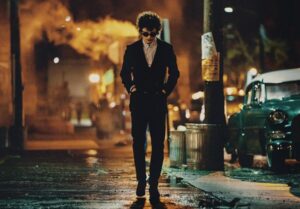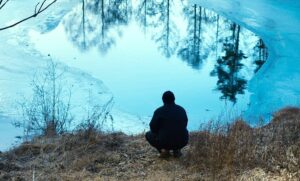Just who is Bob Dylan? It’s impossible to pin down the man born Robert Allen Zimmerman in Duluth, Minn. in 1941, because his persona as songwriter and performer has always been his own ever-changing creation. As he transformed himself, Dylan never quite let go of former selves.
Years after he left protest songs behind, for example, he wrote “Hurricane,” decrying the unjust imprisonment of boxer Rubin “Hurricane” Carter. And years after Dylan converted from bar mitzvah boy to born-again Christian, he lent support to Chabad-Lubavitch, an ultra-orthodox Jewish sect.
Todd Haynes recognized this protean quality when he made his 2007 film I’m Not There, which is more of a meditation on the idea of Dylan than a biopic of the artist. In it, six different actors portray Dylan, from Heath Ledger to Cate Blanchett, in different stages of his career and as a character who emerges from his lyrics.
In real life, Dylan first erupted onto the folk music scene in Greenwich Village in 1961, singing activist anthems in the manner of his idol, Woody Guthrie, and his mentor, Pete Seeger. His fame and reputation have mushroomed ever since. In 2016, he became the only songwriter to have won the Nobel Prize in Literature. And why not? His lyrics create their own poetic mythology, simply expressed yet ineffably complex.
So, when James Mangold, who directed the great Johnny Cash biopic Walk the Line, decided to take on Dylan as a film subject, it was helpful to limit the scope of the effort to the years 1961 to 1965, from the time Dylan arrived in New York to his disruptive electrified rock performance at the Newport Folk Festival in 1965 that enraged folk purists and turned him into a superstar. The result, A Complete Unknown, screening in theaters now, is bookended by these two events.

In creating the film, Mangold adapted a script by former Time critic Jay Cocks, based on a 2015 nonfiction book by Elijah Wald about Dylan going electric. Mangold also benefited from two casting coups: Timothée Chalamet as Dylan and Edward Norton as Seeger. The rest of the cast — including Elle Fanning as Sylvie Russo (based on Dylan’s girlfriend at the time, Suze Rotolo, who was a part-time Wellfleet resident); Monica Barbaro as Joan Baez; Boyd Holbrook as Johnny Cash; and Norbert Leo Butz as folk impresario Alan Lomax — are all up to par, but Chalamet and Norton, who figure prominently in this season’s awards, take things to another level.
By focusing on Dylan’s early years, Mangold turns the film into an examination of musicians, politics, and fame in the 1960s, when youth culture in the U.S. rapidly evolved into an anti–Vietnam War counterculture. At the time, Dylan was itching for personal glory and was keen on reinventing himself in the mold of his heroes. Chalamet captures Dylan’s yearnings, self-absorption, and alienation with uncanny precision, as well as his unique energy, tics, and voice. It’s a masterful portrayal that goes way beyond mimicry. That’s true of Norton as well. He recalls Seeger’s rigor as an activist and his Quaker-like saintliness that borders on sanctimony.

The scenes in the movie build in rhythm as Dylan turns into a phenomenon, with a rise-to-fame, putting-on-a-show vitality that’s more or less conventional. But to Mangold’s credit (and much as he did with Walk the Line), the execution never feels false. Without putting on art-house airs or amping up the lowbrow histrionics, he offers a peek into the dark side of show-biz adulation and calculation. And he uses the narrative of Dylan’s early career to expound on the meaning of his songs and his profound need, as an artist, for reinvention.
The title of the movie comes from “Like a Rolling Stone,” the song that came to symbolize Dylan’s conversion to rock ’n’ roll. But the song’s lyrics, which many saw as a critique of radical chic — some have suggested it’s aimed at Edie Sedgwick, the doomed Warhol socialite and Dylan’s friend — can also be seen as Dylan’s plea to himself, the former “Napoleon in rags,” looking for an escape from being pigeonholed: “How does it feel, how does it feel?/ To be on your own, with no direction home/ Like a complete unknown, like a rolling stone.”
Another movie that has been on critics’ 10-best lists is Evil Does Not Exist, by the Japanese auteur Ryusuke Hamaguchi, which can be streamed on AppleTV and (free to subscribers) on Criterion. Hamaguchi became an international sensation with his previous film, the Oscar-winning Drive My Car, which made a splash at Cannes in 2021. For three hours, that movie follows a widowed theater director in rehearsal and his female driver as they navigate a fascinating web of storytelling, both personal and professional.

Evil Does Not Exist is only 106 minutes and far less elaborate, yet it possesses a similar plaintive worldview. Set in a tiny mountain village that’s a few hours away from Tokyo, it shows the effect of a proposed “glamping” resort (a portmanteau of glamour and camping) on local residents and the pristine environment.
What interests Hamaguchi is not so much local politics but ecology — the interactions between humans and nature and within nature itself. He focuses on a local father and daughter (Hitoshi Omika and Rei Nishikawa) and the PR spokespeople of the glamping firm.

I have never before seen ecological balance so lyrically expressed on-screen. Hamaguchi’s long pans of the sky through the trees or along a stream or of characters walking through the forest are a perfect match for the elegiac strings on the soundtrack. The wintry mountain landscapes are breathtakingly beautiful. But he also has an avant-garde touch, with abrupt shifts in scene and score, and a surreal tragic ending that defies easy interpretation.
The title of Evil Does Not Exist recalls the Magritte painting This Is Not a Pipe (“Ceci n’est pas une pipe”) in its contradiction of apparent reality. But Hamaguchi is no smart-ass. In a quiet and impassive way, the movie is a cry for help. And it’s timely in this age of shameless untruths.



